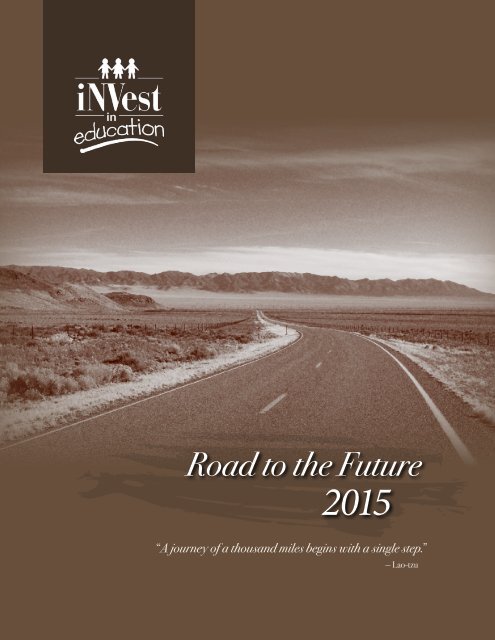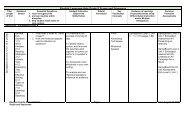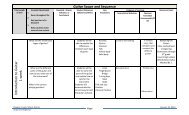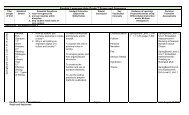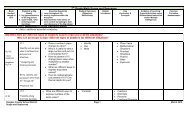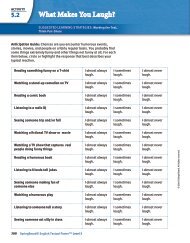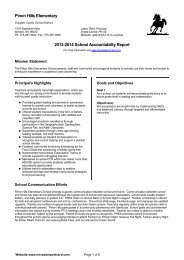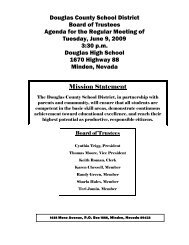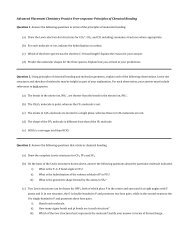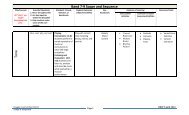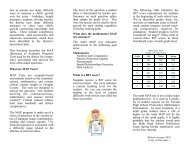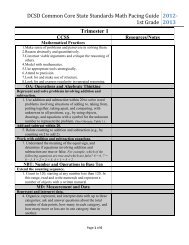iNVest-2013 - Douglas County School District
iNVest-2013 - Douglas County School District
iNVest-2013 - Douglas County School District
Create successful ePaper yourself
Turn your PDF publications into a flip-book with our unique Google optimized e-Paper software.
Road to the Future<br />
2015<br />
“ A journey of a thousand miles begins with a single step.”<br />
— Lao-tzu<br />
1
<strong>iNVest</strong> is the product of the Nevada Association of <strong>School</strong> Superintendents,<br />
comprised of the superintendents of Nevada’s 17 geographic school districts.<br />
Written by superintendents and supported by school board members,<br />
<strong>iNVest</strong> outlines the actions that must be taken to improve education in Nevada.<br />
The superintendents are united in their vision, mission and values that drive the daily work they do<br />
to ensure Nevada’s students have the best opportunities possible on their journey to the future.<br />
Vision<br />
The vibrant future of Nevada is dependent upon all children graduating ready for college and career and prepared<br />
to be productive, responsible citizens, who are competitive in meeting the challenges of the 21st century environment.<br />
Mission<br />
To serve as a united voice to promote and advance public education and to advocate for improving<br />
social and academic achievement for each and every next generation learner.<br />
Values<br />
• Educators are champions of public education<br />
• Graduation begins in kindergarten<br />
• All students<br />
– are embraced, not just those who are successful<br />
– are adaptable to learning and self-directed, self-monitoring,<br />
self-modifying, and self-managing<br />
– want to be successful and are able to meet high academic expectations<br />
when appropriate support is provided<br />
– are engaged in academic rigor, critical thinking, and core values<br />
such as integrity and striving for excellence<br />
• All means all<br />
• Quality education starts with highly effective teachers and administrators<br />
• Resources are essential for educators to meet high expectations<br />
• Grit is an essential element of success: tenacity and persistence must<br />
be developed in our students and educators<br />
• Safe, optimum learning environments are essential to student achievement<br />
• Business is our partner in preparing students to meet the demands<br />
of a 21st century workforce<br />
• All citizens are responsible for the education of our students
Children in Nevada, c. 1920.<br />
University of Nevada Cooperative Extension<br />
<strong>School</strong>house and students at Twin Springs, about 1955.<br />
Nye <strong>County</strong> History Museum<br />
As citizens across the state conclude Nevada’s Sesquicentennial celebration, it is fitting that we<br />
reflect upon our history. Nevada‘s leaders have always known education was important. In 1861, even before<br />
Nevada became a state, the Territorial Legislature provided for a “system of public school support on the<br />
territorial, county and district level.” 1 But “the educational system during the short period of Territorial rule<br />
was a poorly organized and badly supported one.” 2 The Nevada Constitution of 1864 made provisions for “a<br />
uniform system of common, non-sectarian, primary, grammar and high schools” 3 and for financial support for<br />
public schools. In the first 100 years of our state’s history, legislators and educators worked hand in hand to<br />
tackle the issues associated with education.<br />
By 1963, Governor Grant Sawyer spoke of the condition of education in his State of the State Address delivered<br />
to the 52 nd Legislature: “Nevada ranks 18 th in the nation in average teachers’ salaries. We are 5 th in the Western<br />
States. We rank 15 th in the nation on pupil–teacher ratio. We are 8 th in the nation for median number of school<br />
years completed by persons 25 years or older. We reputedly have the highest literacy rate in the nation. We are<br />
4 th in the nation on the basis of money spent per pupil.” 4<br />
By comparison, today’s Nevada doesn’t fare so well. Many measures of student funding rank Nevada at or near<br />
the bottom, and none of them put us even close to the national average. While efforts have been made to change<br />
the trajectory of Nevada’s declining education, much is yet to be done. The authors of the first version of <strong>iNVest</strong><br />
outlined the answer to a single question: “What is needed to improve student achievement in Nevada” Since<br />
<strong>iNVest</strong>’s introduction in 2003, the question has not changed (nor have many of the answers) as we describe<br />
three basic principles and eight specific actions that the Legislature could take to improve education for<br />
Nevada’s 451,000 students:<br />
Provide Support for Our Students<br />
Fund Full-day Kindergarten<br />
Assist Struggling Students<br />
Provide Support for Our Educators<br />
Prioritize Professional Learning<br />
Ensure Access to Appropriate Textbooks, Materials, Assessment and Technology<br />
Make a Financial Commitment to K-12 Education<br />
Fund the Base<br />
Revise the Funding Formula<br />
Establish a Rainy Day Fund<br />
Address Capital Improvement Needs<br />
3
Goldfield <strong>School</strong> 1st grade,1929–30<br />
Esmeralda <strong>County</strong><br />
Goldfield Historical Society<br />
Provide Support<br />
for Our Students<br />
For “Next Generation Learners”<br />
FUND FULL-DAY KINDERGARTEN<br />
Graduation begins in kindergarten.<br />
High school graduation is the widely held indicator for student success, and the first step toward the “walk across<br />
the stage” truly begins in early childhood. Effective early childhood education is an essential stepping-stone in<br />
preparing students for success later in life. The tipping of the K-12 trajectory must start in the earliest grades so<br />
that the work of the climb to graduation is spread out over the years of school. Today’s kindergarten students are<br />
expected to emerge with basic literacy skills and the essential building blocks for math numeracy.<br />
To be competitive, all kindergarten students in Nevada must be provided the opportunity to attend full-day programs.<br />
It is inherently unfair to provide full-day instruction for some students, half-day instruction for others, and expect<br />
some parents to pay for full-day programs. With higher standards and higher expectations, it is essential that our<br />
youngest students have access to the full curriculum and be provided the time necessary to do so. The Legislature<br />
began this mission in earnest with the funding provided by the 2005 Session. Additional progress was made in 2007<br />
and again in <strong>2013</strong>. It is time to finish what was started 10 years ago and make full-day kindergarten a reality in all of<br />
Nevada’s public schools.<br />
Statewide, more than 50% of our kindergarten students are enrolled in full-day programs. Approximately 10% of<br />
our full-day K students are in tuition-based programs. This is an indication that parents feel an all-day program is so<br />
important that they are willing to pay for the experience. Students in half-day programs have as little as two hours and<br />
twenty minutes per day to master skills and knowledge that previously were outcomes of the first grade curriculum.<br />
When students fall behind in their first experience at school, it is likely they will remain behind for the rest of their<br />
educational careers and are at risk of not graduating.<br />
LONG-TERM GOAL:<br />
Fund all kindergarten students at the<br />
full 1.0 weight as a part of the regular<br />
Distributive <strong>School</strong> Account Budget.<br />
SHORT-TERM RECOMMENDATION:<br />
Provide categorical support, including<br />
additional facilities, to complete the roll out<br />
of full-day kindergarten for the remaining<br />
students over the next two years.<br />
4<br />
Children in Rural Nevada<br />
UNLV Library
ASSIST STRUGGLING STUDENTS<br />
We embrace all students, not just those that are successful.<br />
With higher expectations for all students, literacy skills have never been more important. It is reasonable to expect all<br />
students to read at grade level by the third grade. Early identification of struggling readers is essential so students can<br />
receive individualized attention and additional instruction to catch up. Resources for early identification and intervention<br />
will help us ensure that third grade students are proficient not just in reading, but in other core areas as well.<br />
The <strong>2013</strong> State Legislature provided funding for ZOOM schools, tailored to meet the needs of English Language<br />
Learners (ELL). The reading skills centers —integral to the ZOOM school model —are proving to be significant in<br />
identifying students who are struggling with language acquisition and bringing them to grade level. Many students,<br />
not just those who are learning English, experience the challenges of language acquisition. Early interventions for<br />
all students who are falling behind can get a child back on track and ensure that all third grade students master<br />
essential reading skills.<br />
The essential components of the ZOOM school model are:<br />
• Access to preschool<br />
• Full-day kindergarten with class sizes of 21:1<br />
• Reading skills center<br />
• Extended-year learning<br />
The ZOOM school model must be expanded. By using the criteria of (1) schools whose student populations are<br />
comprised of 35% or more English Language Learners and (2) are designated as one- or two-star schools, an<br />
additional 32 elementary schools qualify as ZOOM schools. Nineteen of those schools are in Clark <strong>County</strong>, twelve<br />
are in Washoe, and one in White Pine.<br />
While designed specifically for schools with high populations of English Language Learners, ZOOM strategies<br />
can and should be employed for all struggling students. They provide the fundamental needs of students who are<br />
trying to catch up: additional time on task and individualized attention from an adult who identifies and provides<br />
specifically what the student needs to succeed.<br />
<strong>School</strong>s whose ELL population is less than 35% must also have access to funding to provide assistance to their<br />
struggling students. Additionally, students who are not classified as English Language Learners yet still have<br />
difficulty in English language acquisition and students of all backgrounds who are struggling to learn to read would<br />
benefit from some or all of the same strategies that are employed in ZOOM schools.<br />
The passage of SB504 in the <strong>2013</strong> Session provided meaningful and specific support in this area through greatly<br />
needed categorical funding. Continuation of this effort is needed to continue the momentum.<br />
LONG-TERM GOAL:<br />
Adopt the proposed weighted formula with<br />
the expectation that additional funding will<br />
be used to ensure third-grade literacy for<br />
the students in the weighted categories.<br />
SHORT-TERM RECOMMENDATION:<br />
Expand funding to create 32 additional<br />
ZOOM schools (1 in White Pine, 12 in<br />
Washoe, and 19 in Clark).<br />
Gardenville Elementary <strong>School</strong><br />
<strong>Douglas</strong> <strong>County</strong><br />
Wikipedia Creative Commons<br />
Photo by Jennifer Cooper<br />
5
High school graduate<br />
Class of 1928<br />
Carson City <strong>School</strong> <strong>District</strong><br />
Class photo, 1937, Minden<br />
<strong>Douglas</strong> <strong>County</strong> <strong>School</strong> <strong>District</strong><br />
Winnemucca Grammar <strong>School</strong>, Humboldt <strong>County</strong><br />
Wikipedia Creative Commons, photo by Ken Lund<br />
Provide Support<br />
for Our Educators<br />
For “Next Generation Educators”<br />
PRIORITIZE PROFESSIONAL LEARNING<br />
High-quality education starts with highly effective teachers and administrators.<br />
“Great teachers help create great students. In fact, research shows that an inspiring and informed teacher is the most<br />
important school-related factor influencing student achievement, so it is critical to pay close attention to how we<br />
train and support both new and experienced educators.” 5<br />
Particularly during this time of transition, our educators need support. As the Baby Boomer generation moves into<br />
retirement, a new generation of teachers will need to be recruited, supported and maintained so that they can meet<br />
the needs of Nevada’s students. Think of the landscape our teachers are facing:<br />
• We have adopted the new Nevada Academic Content Standards that require extensive changes in the<br />
curriculum to ensure students are prepared for college or a career.<br />
• Assessments are changing at elementary, middle and high school levels. A new educator performance<br />
framework is being implemented. Student achievement will impact evaluations.<br />
• Existing opportunities to provide training for our teachers in these new standards and initiatives are minimal.<br />
Ongoing, effective professional development needs to be embedded into the school year in a meaningful way for<br />
each district.<br />
Each county would have to determine the most effective method of providing professional development —whether<br />
those additional non-student days would be held periodically throughout the year or whether a model utilizing the<br />
minutes on an ongoing, weekly basis, before or after school, would be adopted.<br />
LONG-TERM GOAL:<br />
By 2020, extend the teacher work<br />
year by the equivalent of five days to<br />
provide necessary time for professional<br />
development and collaboration.<br />
SHORT-TERM RECOMMENDATION:<br />
Increase the equivalent of an additional<br />
day each year of the 2015-17 biennium (for<br />
a total of two additional days).<br />
6<br />
Mount Rose Elementary <strong>School</strong><br />
Reno, Washoe <strong>County</strong><br />
National Park Service;<br />
National Register of Historic Places
Maude Frazier<br />
UNLV Library<br />
Boys Basketball Team, 1920<br />
Carson City <strong>School</strong> <strong>District</strong><br />
High school graduate<br />
Class of 1929<br />
Carson City <strong>School</strong> <strong>District</strong><br />
ENSURE ACCESS TO TEXTBOOKS, MATERIALS,<br />
ASSESSMENTS AND TECHNOLOGY<br />
Educators need appropriate resources to accomplish what is expected of them.<br />
For educators to effectively implement the Nevada Academic Content Standards, it is essential that we provide<br />
textbooks, materials and other resources, both digital and traditional, to assist them. As a part of the budget cuts during<br />
our state’s economic downturn, textbook allocations were first reduced and then eliminated. While challenging,<br />
<strong>District</strong>s understood the need to trim budgets and textbook adoptions were placed on hold.<br />
As we move forward with more rigorous standards and new assessments to match, we simply must provide<br />
the resources that our students and their teachers (including parents) need to be successful. Taking exams and<br />
assessments online is no longer a requirement we anticipate happening in the future —it is a part of today’s reality.<br />
Students must have access to appropriate devices in sufficient quantity to participate fully. We must also have<br />
resources that support parents when they help their children with homework. Teachers need essential classroom<br />
materials in order to teach their classes.<br />
LONG-TERM GOAL:<br />
Ensure adequate, ongoing categorical<br />
funding is provided for textbooks,<br />
assessments, technology and<br />
infrastructure.<br />
SHORT-TERM RECOMMENDATION:<br />
1. Revisit the appropriateness of the<br />
“Minimum Expenditure Requirement”<br />
(MER) so as not to punish school<br />
districts with a requirement that is not<br />
current with school funding and costs.<br />
2. Assess the technological needs<br />
of schools and districts and fund<br />
what is needed for compliance with<br />
the mandated assessments and<br />
curriculum.<br />
Pershing <strong>County</strong> Middle <strong>School</strong>, Lovelock<br />
Photo by GuiDenby, Inc.<br />
7
Oats Park Grammar <strong>School</strong>, Fallon, Churchill <strong>County</strong><br />
National Park Service, National Register or Historic Places<br />
Photo by William Hoffknecht<br />
Make a<br />
Financial Commitment<br />
to K-12 Education<br />
For “Next Generation Achievement”<br />
FUND THE BASE<br />
Educators are champions of public education.<br />
Without a strong foundation, a building will collapse under its own weight. The same is true for education. A strong<br />
fiscal base that provides adequate funding for all students is the first step in constructing a strong stable educational<br />
system. Without this solid base, the efforts to meet the needs of our specialized student populations will collapse<br />
under the weight of inadequate support for all students. While the funding formula must be revised if we are to meet<br />
the needs of children in poverty, English language learners and students with learning challenges, this cannot be<br />
done at the expense of the basic educational needs of all students.<br />
The Augenblick study (commissioned by the Nevada Legislature in 2006) clearly demonstrated that the funding for<br />
Nevada schools is inadequate, but the recommendations were not implemented because the price tag was too high.<br />
If we had committed to a 10-year phase-in funding plan in the 2007 Session, we would be approaching the national<br />
average this year. In recent years, the financial hit to our economy dug a hole for most systems and businesses<br />
including Nevada’s K-12 school districts. Although the <strong>2013</strong> Session began the work of repairing that damage, we<br />
are still in a hole. If the Legislature creates a new funding formula without addressing the inadequacy of the base<br />
funding for education, we may never climb back out of the hole.<br />
Funding the base is the ultimate responsibility of the Legislature. Regardless of which yardstick is used to<br />
measure education funding, Nevada continues to lag on the national scene. Nevada’s educators are facing higher<br />
expectations and working with more challenging student populations—yet are receiving comparably fewer<br />
resources. The moral obligation to improve student achievement will not be met without providing sufficient<br />
funding to provide for necessary materials, services and programs. The cost of operating K-12 education<br />
increases continually, even when we are not expanding the scope of what we provide. The cost goes up for providing<br />
required items such as utilities and fuel, salaries and benefits. Buses and textbooks need replacing. If we do not<br />
implement a plan that addresses these ever increasing costs, the quantity and quality of what we offer our students<br />
will continue to diminish.<br />
8<br />
Eureka <strong>County</strong> High <strong>School</strong>, Eureka<br />
Photo by VanWoert Bigotti Architects
What would it cost to bring Nevada’s per-pupil funding to the national average While “average” is a moving target,<br />
Governing.com 6 reports the 2011 totals for Nevada as $8,526.85 and the national average as $10,559.70. With<br />
an estimated enrollment of 451,000 students, multiplied by an increase of $203 per pupil, adding $91.6 million to<br />
the base per year for the next 10 years would put us at or near the average. For Nevada to have gone from “4 th in the<br />
nation on the basis of money spent per pupil” 7 to last in the nation in a period of 50 years is deplorable. To dedicate<br />
the next ten years to recovering at least part of that ground is essential.<br />
LONG-TERM GOAL:<br />
Fund K-12 education in Nevada at a level<br />
commensurate with the national average<br />
by 2025.<br />
SHORT-TERM RECOMMENDATION:<br />
Achieve the 2025 goal by increasing the<br />
base incrementally in each of the next five<br />
sessions. ($406 per student for each of the<br />
next five biennia or $203 per year for each<br />
of the next ten years.)<br />
REVISE THE FUNDING FORMULA<br />
All means all.<br />
Certain populations of students require more time and attention in order to succeed in school and be college and<br />
career ready upon graduation. These populations tend to include those who are English Language Learners, children<br />
who live at or below the federally defined poverty level, and students enrolled in special education programs. In their<br />
2012 study of the funding formula for Nevada schools, the American Institutes for Research concluded that the<br />
Nevada Plan has inequities in it.<br />
The passage of SB500 in <strong>2013</strong> created the Task Force on K-12 Public Education Funding. The Task Force was<br />
required to study the Nevada Plan and make recommendations based upon a weighted formula that takes into<br />
account the individual educational needs and demographic characteristics of pupils. Its membership includes<br />
legislators, school administrators, board members, a superintendent and teachers —supported by the Technical<br />
Advisory Committee, comprised of experts in school funding. The recommendations of the Task Force include<br />
weighted funding for students living in poverty, enrolled in special education, and English Language Learners.<br />
While the superintendents and school boards maintain that a weighted formula for our DSA will not work unless<br />
the base upon which it is calculated is adequate, we believe that all Nevada students —whether located in an urban,<br />
suburban or rural setting —deserve an education that will prepare them to compete in our 21 st century global economy.<br />
<strong>School</strong> boards from all 17 counties passed a resolution to support a revised funding formula and encouraged its<br />
implementation along with the increased funding the new formula will require.<br />
This is the challenge facing the 2015 Legislature: funding for public schools in Nevada must be both adequate and<br />
equitable. The goal remains unchanged since the inception of <strong>iNVest</strong>: to improve student achievement through<br />
adequate funding.<br />
LONG-TERM GOAL:<br />
Implement a weighted funding formula to<br />
provide additional supports for struggling<br />
learners through categorical funds.<br />
SHORT-TERM RECOMMENDATION:<br />
Review the recommendations of the Task<br />
Force on Public Education K-12 Funding<br />
and use categorical funding to phase in the<br />
necessary increases to a weighted formula<br />
over the next 10 years.<br />
9
Las Vegas Grammar <strong>School</strong>, 1911<br />
Clark <strong>County</strong> <strong>School</strong> <strong>District</strong><br />
ESTABLISH A “RAINY DAY” FUND<br />
All citizens are responsible for the education of our students.<br />
Establishing an education stabilization fund would be beneficial regardless of whether Nevada’s economy is<br />
robust or struggling. In plentiful years, money would be set aside to preserve education funding during difficult<br />
economic times. In years when we struggle, the reserves could be used to ensure critical education programs are<br />
not cut. Additionally, it is not unreasonable to expect that revenues collected from tax payers under the banner of<br />
education actually remain in education budgets.<br />
The formula in The Nevada Plan uses multiple calculations to determine the level of funding those school districts<br />
will receive, ultimately solving for the state’s contribution after deducting other sources of revenue. Basic per pupil<br />
support is the level of funding deposited into the Distributive <strong>School</strong> Account (DSA); it is not the actual cost of<br />
education programs nor does it reflect all of the money spent in support of those programs.<br />
The cost of other education programs are then calculated “outside the DSA,” where revenues that are local in name<br />
only [e.g., local school support sales tax and ad valorem (property) tax] as well as certain other state revenues are<br />
subtracted from the estimated cost of education programs. The remaining program cost is referred to as the “state<br />
funding requirement,” a gap that is filled with State General Fund appropriations. The result is a formula that’s<br />
difficult to calculate, challenging to explain, and hard to understand.<br />
The resulting “guaranteed per-pupil funding,” always results in either a surplus or a deficit of state dollars to the<br />
State’s General Fund. When there is a deficit, the expectation is that the Legislature will find additional revenues<br />
to support education to honor the guarantee, which comes in the form of a supplemental appropriation. When the<br />
revenues come in higher than needed to honor the guarantee, the state reverts surplus education dollars to the State<br />
General Fund where they are budgeted for other pressing state needs (which may or may not include education<br />
programs).<br />
10<br />
Mary Lee Nichols <strong>School</strong><br />
Sparks, Washoe <strong>County</strong><br />
National Park Service;<br />
National Register of Historic Places
Goldfield High <strong>School</strong>, 1908<br />
Esmeralda <strong>County</strong><br />
Goldfield Historical Society<br />
Applied Analysis 8 provided an in-depth look at how the formula has worked over the past 35 years. Since 1979,<br />
$765 million of funding generated by taxpayers for the purpose of supporting K-12 education has been reverted to<br />
the State General Fund and used for other purposes.<br />
With the turbulent economy we’ve experienced in recent years, the state has also had to honor its obligation to meet<br />
the guaranteed per-pupil funding, and those supplemental appropriations have totaled $603 million, leaving a net<br />
balance of $183 million that has been diverted from education. However, these figures do not reflect cuts to K-12<br />
education programs during the same period, which take the net balance of this formula to nearly $335 million in<br />
reversions or funding obligations not met during that same study period.<br />
It is worth noting here that if the state had used a “rainy day fund” approach, it would have been able keep K-12<br />
education funding much closer to “whole” through the worst economic downturn in Nevada’s history.<br />
LONG-TERM GOAL:<br />
Create an education stabilization fund<br />
where DSA reversions over the 10 percent<br />
threshold are allocated to Nevada’s school<br />
districts on a per-pupil basis to be used for<br />
non-recurring expenditures such as capital<br />
improvements, professional development,<br />
and equipment purchases.<br />
SHORT-TERM RECOMMENDATION:<br />
Require that “reversion” funds remain in<br />
an education rainy day fund until such time<br />
as they accumulate to 10 percent of the<br />
annual DSA revenues.<br />
Lander <strong>County</strong> High <strong>School</strong>, Austin<br />
Wikipedia Creative Commons<br />
Photo by Ammodramus<br />
11
Old Glendale <strong>School</strong>, Sparks, Washoe <strong>County</strong><br />
Wikipedia Creative Commons; photo by Ken Lund<br />
ADDRESS CAPITAL INFRASTRUCTURE NEEDS<br />
Safe, optimum learning environments are essential for student achievement.<br />
The physical environment in which we teach children can have a profound impact on the success of our students.<br />
<strong>School</strong> districts have very limited options to raise funds for school buildings and all of them require either legislative<br />
or voter approval. In fact, school districts must get approval from other local governments to place a question on the<br />
ballot. This is doubly challenging when these same local governments are competing for the same revenue.<br />
One of the fundamental questions the state must answer is, “Whose responsibility is it to provide the physical<br />
structures for our students” With very few exceptions, the responsibility has been placed on local districts to<br />
generate local revenues for school construction and ongoing renovation. Because school boards have not been<br />
granted taxing authority, the State Legislature has established the method used in each county. Superintendents and<br />
<strong>School</strong> Boards accept the responsibility to provide appropriate school facilities, but they must have the appropriate<br />
statutory authority to do so.<br />
Eleven of the 17 countries have reached (or are within pennies of) the property tax cap of $3.64 and the only ballot<br />
questions districts can pose are to raise property tax. The Legislature has not provided any avenues for districts to<br />
generate additional funding if their county is at the tax cap and (except in rare and extreme circumstances) the state<br />
does not provide capital funding.<br />
Without adequate funding for the maintenance and modernization of existing school facilities, districts will be forced<br />
to raid razor-thin operating budgets in order to pay for repairs to plumbing, electrical, and HVAC systems as they<br />
arise, or be forced to close down schools and bus children to other overcrowded buildings. In some cases, districts<br />
have to choose between textbooks and toilets.<br />
12<br />
Mineral <strong>County</strong> High <strong>School</strong><br />
Hawthorne<br />
Mineral <strong>County</strong> <strong>School</strong> <strong>District</strong>
Southside <strong>School</strong>, Reno<br />
Washoe <strong>County</strong><br />
National Park Service<br />
National Register of Historic<br />
Places collection<br />
Photo by Michelle McFadden<br />
Elgin <strong>School</strong>house, 1922<br />
Lincoln <strong>County</strong><br />
Kershaw-Ryan State Park near Caliente<br />
Just like homeownership, these investments need to be maintained and equipped to provide a safe and effective<br />
learning environment in which children can focus on succeeding in the 21 st century workplace. The community<br />
has invested millions of dollars to construct these buildings, however not enough resources have been allocated to<br />
maintain the school facilities in our state.<br />
In addition to deferred maintenance and renovation needs, counties facing ongoing growth are unable to provide<br />
the seats necessary for their student population. After static growth during the Great Recession, student enrollment<br />
has grown consistently statewide over the past three years, exceeding 1%—over 4,000 new students per year—with<br />
only one new school facility (built in Lyon <strong>County</strong>) to accommodate them. The cost of new construction ranges<br />
from $25–$100 million per building, depending on school level and size. Sufficient resources are not available<br />
to support the extensive additional expense. Even if voters will support ballot questions, property tax revenues<br />
grow only as residential enrollments grow, and the revenue growth isn’t enough to support the high upfront cost<br />
of building schools. Additionally, as we begin a hopefully robust economic recovery, we have imposed limits on<br />
property tax revenue growth with the residential and commercial tax caps of 3% and 8%, respectively. Therefore,<br />
even if residential property tax values grow at a rate of 5%, for example, local governments (including school districts)<br />
will realize only a 3% increase. This is frustrating given the fact that property tax values dropped so drastically and<br />
now we won’t be able to “grow our way to prosperity” at the market rate. Because of a self-imposed slow growth rate,<br />
districts will leave millions of dollars unrealized that could be devoted to the necessary school infrastructure needed<br />
statewide.<br />
LONG-TERM GOAL:<br />
Implement additional funding mechanisms<br />
that are dedicated exclusively for school<br />
facilities OR provide local elected officials<br />
with the authority to generate funding<br />
for the maintenance, renovation and<br />
construction of school facilities.<br />
SHORT-TERM RECOMMENDATION:<br />
1. Reconsider property tax caps that limit<br />
school district access to property tax<br />
revenue to fund school infrastructure.<br />
2. Provide categorical grants to districts<br />
to ensure all schools can provide<br />
the necessary technology to deliver<br />
education in today’s environment.<br />
Grammar <strong>School</strong>, Elko<br />
Elko <strong>County</strong><br />
Northeastern Nevada Museum<br />
13
White Pine Middle <strong>School</strong>, Ely, White Pine <strong>County</strong><br />
Photo by Dale Romero<br />
Golconda <strong>School</strong>, Humboldt <strong>County</strong><br />
Wikipedia Creative Commons; photo by Ken Lund<br />
Midas <strong>School</strong> House<br />
Elko <strong>County</strong><br />
Photo by Marco Oro<br />
Forth Ward <strong>School</strong><br />
Virginia City<br />
Storey <strong>County</strong><br />
Nevada State Historic<br />
Preservation Office<br />
“ If one advances confidently<br />
in the direction of his dreams and<br />
endeavors to live the life which he has<br />
imagined, he will meet with a success<br />
unexpected in common hours.”<br />
— Henry David Thoreau<br />
Minden Grammar <strong>School</strong><br />
<strong>Douglas</strong> <strong>County</strong><br />
Wikipedia Creative Commons<br />
Photo by Asilvero<br />
Goodsprings <strong>School</strong>house<br />
Clark <strong>County</strong><br />
Wikipedia Creative Commons<br />
Photo by Ymblanter<br />
Overton Gymnasium<br />
Clark <strong>County</strong><br />
Wikipedia Creative Commons<br />
Photo by Ymblanter<br />
1. “Historical Perspective on Major Education Changes 1861–1966;” p.2,<br />
prepared by J. Clark Davis and Mary Davis; 1966<br />
2. Ibid<br />
3. The Constitution of the State of Nevada, Article XI, Section 2<br />
4. Nevada State Legislature Fifty-Second Session, The Second Day, Governor’s<br />
Address to the Legislature<br />
5. Why Is Teacher Development Important; Edutopia, May 10, 2014<br />
6. www.governing.com/gov-data/education-data/state-education-spendingper-pupil-data.html<br />
7. Nevada State Legislature Fifty-Second Session, The Second Day, Governor’s<br />
Address to the Legislature<br />
8. Applied Analysis is a Las Vegas–based research and analysis firm that<br />
specializes in analytics related to economics and fiscal impact.<br />
14
The Cottage <strong>School</strong>s, Fallon, Churchill <strong>County</strong><br />
National Register of Historic Places; photo by William Hoffknecht<br />
Dayton <strong>School</strong> House, Lyon <strong>County</strong><br />
Nevada State Historic Preservation Office<br />
We are preparing our children to be problem solvers for issues that don’t yet exist,<br />
in jobs we have not yet imagined, because of new technology that has not yet been invented.<br />
Our world is changing rapidly. We need our students to think at a higher level and apply<br />
learned skills to solve difficult problems in a contextual situation – not just memorize<br />
individual bits of information that could be found on the Internet in less than a second.<br />
We want Nevada students to be great thinkers and doers, whether their adventures and<br />
choices in life take them to a career that is just across town or on the other side of the world.<br />
If we’ve done our jobs well, our students should leave us prepared to collaborate with and<br />
compete with those who come from private school educations or those who come from states<br />
with more impressive K-12 statistics.<br />
Today’s American workplace is not the same one our parents worked in while they were<br />
raising us. In the early 1970s, 72% of all U.S. jobs were held by adults with a high school<br />
diploma or less. Today, over 66% of all new jobs are tied to a college degree.<br />
Nevada’s children are counting on us to ensure that we don’t leave them with a gap between<br />
what they learned in K-12 and what they need to be able to do to succeed in their first phase<br />
of adulthood. The Great Recession forced us to analyze where the future jobs are for our<br />
students and maybe more importantly – where they are not.<br />
Our children are counting on us to challenge them. They deserve a vibrant future that is<br />
supported by a strong education in their youth. They need us to help them reach high.<br />
Nevada’s school board members and superintendents are united to promote and advance<br />
public education and to improve achievement and success for all students.<br />
We must all be accountable. Students must accept personal responsibility to learn.<br />
Parents must accept the responsibility of ensuring their children are in school and have the<br />
support at home to create success. Teachers must be prepared to assist students for the<br />
demands in an ever-changing global society. Administrators must use resources in a way that<br />
positively impact the classroom. Superintendents must set high expectations for students,<br />
staff and themselves. <strong>School</strong> boards must ensure that budgets are set to support the priorities<br />
of student learning. And during the 2015 Session, our legislators must have the collective will<br />
to provide adequate resources so everyone else can do their jobs.<br />
Educators cannot do this alone.<br />
15
NEVADA ASSOCIATION OF<br />
SCHOOL SUPERINTENDENTS<br />
Mr. Richard Stokes, Superintendent Carson City <strong>School</strong> <strong>District</strong><br />
Dr. Sandra Sheldon, Superintendent, Churchill <strong>County</strong> <strong>School</strong> <strong>District</strong><br />
Mr. Pat Skorkowsky, Superintendent, Clark <strong>County</strong> <strong>School</strong> <strong>District</strong><br />
Dr. Lisa Noonan, Superintendent, <strong>Douglas</strong> <strong>County</strong> <strong>School</strong> <strong>District</strong><br />
Mr. Jeff Zander, Superintendent, Elko <strong>County</strong> <strong>School</strong> <strong>District</strong><br />
Ms. Monie Byers, Superintendent, Esmeralda <strong>County</strong> <strong>School</strong> <strong>District</strong><br />
Dr. Greg Wieman, Superintendent, Eureka <strong>County</strong> <strong>School</strong> <strong>District</strong><br />
Dr. David Jensen, Superintendent, Humboldt <strong>County</strong> <strong>School</strong> <strong>District</strong><br />
Mr. Jim Squibb, Superintendent, Lander <strong>County</strong> <strong>School</strong> <strong>District</strong><br />
Mr. Steve Hansen, Superintendent, Lincoln <strong>County</strong> <strong>School</strong> <strong>District</strong><br />
Mr. Keith Savage, Superintendent, Lyon <strong>County</strong> <strong>School</strong> <strong>District</strong><br />
Mr. Chris Schultz, Superintendent, Mineral <strong>County</strong> <strong>School</strong> <strong>District</strong><br />
Mr. Dale Norton, Superintendent, Nye <strong>County</strong> <strong>School</strong> <strong>District</strong><br />
Mr. Dan Fox, Superintendent, Pershing <strong>County</strong> <strong>School</strong> <strong>District</strong><br />
Dr. Robert Slaby, Superintendent, Storey <strong>County</strong> <strong>School</strong> <strong>District</strong><br />
Mr. Pedro Martinez, Superintendent, Washoe <strong>County</strong> <strong>School</strong> <strong>District</strong><br />
Mr. Robert Dolezal, Superintendent, White Pine <strong>County</strong> <strong>School</strong> <strong>District</strong><br />
NEVADA ASSOCIATION OF<br />
SCHOOL BOARDS<br />
Executive Committee<br />
President Dr. Greg Koenig, Churchill <strong>County</strong> <strong>School</strong> <strong>District</strong><br />
President-Elect Erin Cranor, Clark <strong>County</strong> <strong>School</strong> <strong>District</strong><br />
Vice President Joe Crim, Jr., Pershing <strong>County</strong> <strong>School</strong> <strong>District</strong><br />
Legislative Chair Wade Poulsen, Lincoln <strong>County</strong> <strong>School</strong> <strong>District</strong><br />
Immediate Past President Chris Miller, Storey <strong>County</strong> <strong>School</strong> <strong>District</strong><br />
Past President Carolyn Edwards, Clark <strong>County</strong> <strong>School</strong> <strong>District</strong><br />
Past President Sharla Hales, <strong>Douglas</strong> <strong>County</strong> <strong>School</strong> <strong>District</strong><br />
Washoe Liaison to the Executive Committee<br />
Dr. Barbara McLaury, Washoe <strong>County</strong> <strong>School</strong> <strong>District</strong><br />
Rural Liaison Lou Basanez, Elko <strong>County</strong> <strong>School</strong> <strong>District</strong><br />
At-Large Liaison Lori Hunt, White Pine <strong>County</strong> <strong>School</strong> <strong>District</strong><br />
Board of Directors<br />
Stacie Wilke-McCulloch, Carson City <strong>School</strong> <strong>District</strong><br />
Steve Nunn, Churchill <strong>County</strong> <strong>School</strong> <strong>District</strong><br />
Chris Garvey, Clark <strong>County</strong> <strong>School</strong> <strong>District</strong><br />
Cindy Trigg, <strong>Douglas</strong> <strong>County</strong> <strong>School</strong> <strong>District</strong><br />
Lou Basanez, Elko <strong>County</strong> <strong>School</strong> <strong>District</strong><br />
Doug Kile, Esmeralda <strong>County</strong> <strong>School</strong> <strong>District</strong><br />
John Brown, Eureka <strong>County</strong> <strong>School</strong> <strong>District</strong><br />
Glenda Deputy, Humboldt <strong>County</strong> <strong>School</strong> <strong>District</strong><br />
Susan Davis, Lander <strong>County</strong> <strong>School</strong> <strong>District</strong><br />
Patrick Kelley, Lincoln <strong>County</strong> <strong>School</strong> <strong>District</strong><br />
Jason Sanderson, Lyon <strong>County</strong> <strong>School</strong> <strong>District</strong><br />
Barbara Lancaster, Mineral <strong>County</strong> <strong>School</strong> <strong>District</strong><br />
Tracie Ward, Nye <strong>County</strong> <strong>School</strong> <strong>District</strong><br />
Joe Crim, Jr., Pershing <strong>County</strong> <strong>School</strong> <strong>District</strong><br />
Pamela Smith, Storey <strong>County</strong> <strong>School</strong> <strong>District</strong><br />
John Mayer, Washoe <strong>County</strong> <strong>School</strong> <strong>District</strong><br />
Pete Mangum, White Pine <strong>County</strong> <strong>School</strong> <strong>District</strong><br />
16


